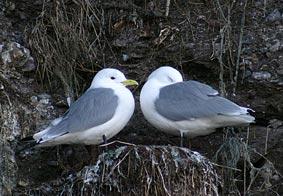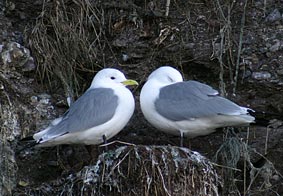Birds: Kittiwake

Though perhaps not familiar to many readers, the Kittiwake is a common breeder on cliffs all around the Irish coast; around 50,000 pairs nest here. A member of the gull family, it occurs in both the North Atlantic and North Pacific, and it is by far the most numerous species of gull in the world.
The Kittiwake is more marine than our other breeding gull species, and outside the breeding season most are to be found far out on the open ocean, though some do remain around our coasts.
One of our smaller gulls, at 38cm in length, the Kittiwake closely resembles many of our white-headed, grey-winged gull species, but can easily be identified given close views by its combination of a small yellow bill, dark eye, all-black wingtips and, unique amongst Irish breeding gulls, its black legs. Juvenile birds look quite different, showing a highly distinctive black "W" pattern on the wings in flight.
Interestingly, Kittiwakes only have three toes on each foot, whereas our other gulls all have four: its scientific name translates as "three-toed gull".
The English name of the species is derived from its raucous call, uttered on the breeding grounds: a high-pitched "ki-ti-waark", frequently repeated.
NIALL HATCH
?More If you would like more information on Kittiwakes or any of Ireland's other birds, or would like to join BirdWatch Ireland and support their conservation work, please call 01 2819878, email info@birdwatchireland.ie or visit www.birdwatchireland.ie. The website also contains detailed information about BirdWatch Ireland's seabird conservation projects
